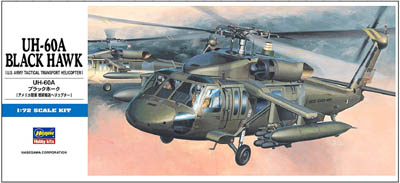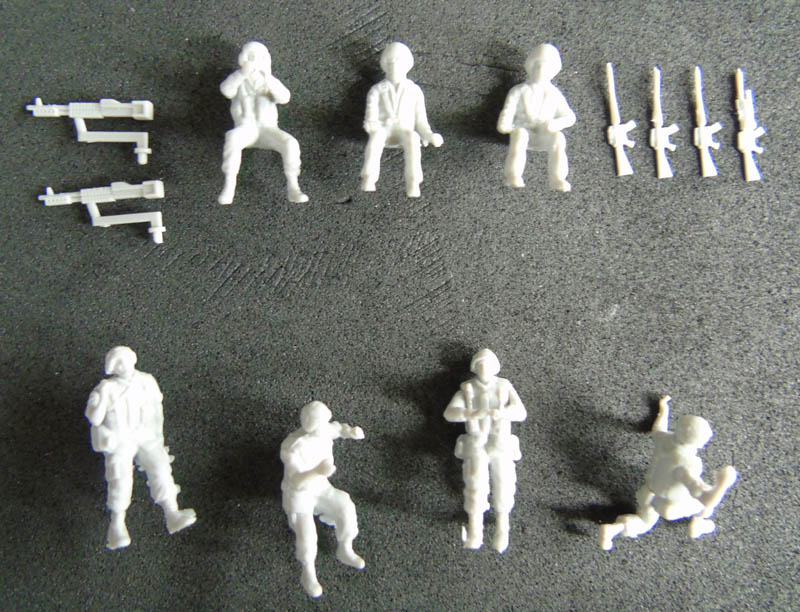

The Sikorsky S-70 or more notably UH-60 Blackhawk helicopter hardly needs any introduction. It has been a workhorse of the US Army since 1979, well depicted in the 'Black Hawk Down' movie (2001) and seen in numerous news from many conflict zones. It is still used at the time of writing this review despite proceedings with selection of its successor.
Hasegawa has released a number of UH-60 Blackhawk models but the army version was basically the same set of sprues complimented by an additional sprue that defined the particular variant. Despite this raising some accuracy issues (advanced variants still look like UH-60A) Hasegawa’s model remains one of the most accurate depictions of the UH-60 Blackhawk. It also contains an interesting set of figures on its basic set of sprues, meaning that every single Blackhawk/Night Hawk/ VIP Hawk from Hasegawa will also contain these figures.
There are 7 figures in the Hasegawa model - three crew members and four troops. Crew members are two distinct pilots and a crew chief /gunner. All of them are wearing coveralls that could be a standard issue CWU-27/P and a flight helmet that is passable for several types of modern flight helmets, including Gentex HGU-56/P (although this particular period would need an SPH-4 series helmet). Pilots do not seem to have any kind of vests (which is reasonable given the time spent on their seats strapped) but they have the seat belts modelled on them. The crew chief does seem to wear a SRU-21/P flight vest. All three crewmen are very nicely done, with good detail and useful position - unlike most pilots added to the helicopter kits (often modelled in a single pose and with jet fighter pilot gear on) these look like a working helicopter crew. Pilots are single molded pieces so the reservation one may have is that their hands are not interacting with collectives and cyclics. Crew chief has his arms molded separately which allows a variety of poses, although he is originally intended to man an M-60 machine gun on one of the sides.
The four troops are the most interesting part of this set, mainly because of their unique pose setup. The first figure on the right is already deployed to the ground, kneeling and signalling with the left arm. It is a three part figure so the torso twist and the right hand can be positioned in any way. Next behind him is a patrolling or carefully advancing figure with both arms molded separately for more versatility. Another figure looks like a soldier landing on the ground after jumping off the helicopter, a pretty unique pose in the hobby and a needed one too. Both his arms (raised in front of him, apparently for balancing purpose) are again molded separately to ensure a more realistic hold of a desired weapon. Finally there is a somewhat mysterious pose of a soldier with his arm modelled stretched and tight to his torso and another arm molded separately raised and bent. This figure is actually making a lot of sense when placed 'sitting' on the helicopter’s floor, stretched hand giving a stabilization for a person to jump off the helicopter with legs already being thrown to the front to ensure a smooth jump. Most people jump off any higher seating this way. However a PLF (Parachute Landing Fall) jump cannot be depicted using these figures.
All figures are US soldiers wearing PASGT body armor and helmet, ALICE webbing and what seems to be a BDU uniform. This places them well along sets of similar 1980’s US soldiers from ESCI or Revell and indeed they do look good when placed together on the diorama or display. Some of them have their sleeves rolled up (which according to regulations was not allowed). They are multipart pieces and the weapons are molded separately. The molds are showing some wear by the time of writing this review - there is some flash that needs to be filed.
Weaponry is well made and consists of 3 M16A1s , one M16/M203 and two M60s on M144 weapon system mounts. The M60s cannot be carried of course but can be fitted on board and manned by crew chief. Despite the nice design, the M60s do not have any ammunition feeding mechanism modelled. M16s do not have the front sight modeled. The choice of M16A1 for the troops is somewhat confusing given that they are all equipped with PASGT body armor systems. This leaves a very narrow timeframe - UH-60 adopted in 1979, M16A1 replaced by M16A2 in the mid-80s and PASGT introduced in early 80’s give the period between 1981 and 1986. Overall these weapons are very nicely done and are a very useful addition themselves, although they do require adding some detail.
This set of figures added to the model by Hasegawa is a very useful one to compliment both multiple helicopter models with realistic crew as well as probably the only existing set of US soldiers actually deploying from the helicopter as a team.